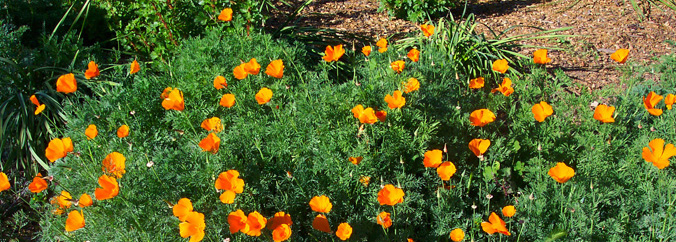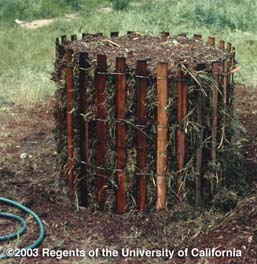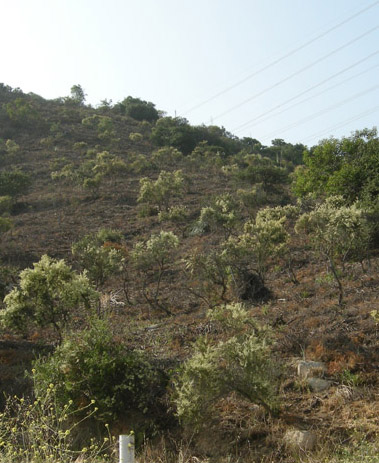Spring

Early spring is a good time to give your irrigation system a check-up. Water plants deeply and only as needed. This encourages deep roots and drought tolerance, and discourages weeds, overgrowth, and snails.

Compost pile
If you haven’t already, start composting greenwaste as part of your spring cleaning. Also, leaving grass clippings on your lawn as mulch provides nutrients to your soil, helps retain soil moisture, and keeps green waste out of landfills . For more information, read these publications: Compost in a Hurry, and Mowing your Lawn and Grasscycling
FIRE PREPAREDNESS FOR YOU AND YOUR PROPERTY
• Be ready! Have a plan of action in place in case a wildfire occurs in your area.
• Remove all stacks of construction materials, yard waste, and other debris from your yard.
• Pull weeds or weed whip before the seed heads mature, to reduce fire hazards and invasive plant seed banks. This may occur any time between February and April, depending on the previous year’s weather.
• Pre-cut and label materials to cover your windows and vents in the event of a fire, and store them, along with a hammer and nails or drill screws, in an easily accessible place.
• Locate woodpiles and fuel tanks at least thirty feet from all structures and maintain a 10 foot zone free of vegetation around them.
• Make sure your decks, porches, or landings are free of unnecessary clutter and that anything remaining can be quickly and easily removed.
• Be sure to keep your “water reservoirs” and portable tanks filled, and have mops and hoses stored with the rest of your emergency supplies (ladders, shovels, etc.).
Before you begin your spring garden tasks, be aware that most birds nest from March to September. Make sure that fuel management activities do not disturb nests. Look first before cutting. For more information from the US Fish and Wildlife Service, please click here.
FIRE HAZARD REDUCTION - IT’S YOUR RESPONSIBILITY!


Brush clearance, weed abatement, and fuel modification are all terms used by fire jurisdictions to describe required treatment or thinning of vegetation on your property to reduce fire hazards.
This DOESN’T mean the clearance of all vegetation, but selective removal to decrease fire risk. In most jurisdictions, You are only required to treat the vegetation on your own property. Brush clearance on other property is the responsibility of the owner. Contact your local forestry or fire personnel if such clearance is needed. Too often, vegetation is allowed to grow unmanaged until it becomes a critical fire hazard. Generally, when this occurs, extensive effort is required by the property owner to address the problem. Some jurisdictions have more specific requirements for brush clearance inspections. Please check with your local fire department for more information. Inspections are usually conducted by your local fire department. Additional requirements may be made by insurers. Please contact your insurance agent or insurance company for additional information, or visit http://www.disaster101.com.
Proper fuel reduction maintains erosion resistant vegetation. Photo by J. Lopez, Los Angeles County Fire Department
FUEL MODIFICATION
• Landscape with plants that have fire-resistant characteristics (see Summer). Maintain plants by watering as needed, and by removing dead or dry growth, leaves and needles.
• Maintain your defensible space by thinning vegetation at least 100 feet from all structures. Space individual or clumps of native trees and shrubs at least ten feet apart and remove the lower six feet of branches on trees taller than eighteen feet.
• Call your local utility company before pruning near power lines or before planting trees close to any power line to confirm the maximum tree height allowable for that location. Ask your local utility company to inspect yearly any utility lines adjacent to or on your property where they may contact trees.
Do NOT remove vegetation down to bare soil, and do not destabilize hillsides by using heavy equipment; soil erosion and mudslides can result. Contact your fire department, a city engineer, or local NRCS office for erosion control techniques. Make sure brush clearance contractors understand the importance of maintaining stable slopes.
Cool winter and spring days are the best time to do fire hazard reduction in hazardous areas. Make sure mechanical tools have approved spark arrestors, and avoid using them on hot dry days when sparks can ignite vegetation. Please click here for information about safe equipment use from CAL FIRE.
